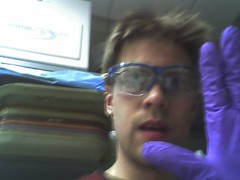Brain Awareness Week: Highlight Reel 1
Seeing as how it's Brain Awareness Week and all, it seems sensible to give you a few highlights of brain-related news, discussions, and lectures that have been placed on the web over the last few days.
Thanks to Scientific American, we have a short piece on using nanofibers as a scaffolding to assist in the repair of damaged neurons:
A team of neuroscientists at the Massachusetts Institute of Technology and their colleagues at Hong Kong University purposefully wounded 53 newly born hamster pups. They cut a relatively deep gash--1.5 millimeters deep and two millimeters wide--through the optic tract in the brains of the young rodents. The wounds of 10 of the pups were then treated with 10 microliters of a solution composed of 99 percent water and 1 percent of a special ionic peptide. These short amino acids are capable of creating a molecular scaffold that can bridge such gaps.
Within 24 hours, the gash in the treated pups had begun to close (shown by the green area in the picture above, depicting regrowth), and by 30 days had completely closed. "We had never seen that before in any animals," says neuroscientist Rutledge Ellis-Behnke of M.I.T., who led the research. By placing a biological tracer in the hamsters' eyes the researchers also discovered that the neurons had actually grown back and reconnected through the center of the cut instead of routing around the wound--another first. None of the control animals showed any healing whatsoever.
The scientists then inflicted a similar wound on some adult hamsters to see if such connections could actually regenerate vision. By injecting 30 microliters of the solution, the scientists again healed the gaps in 30 days. And in subsequent behavioral tests, the animals had regained the ability to turn their eyes and heads toward a sunflower seed in their peripheral vision, though their turning response was slower than normal.
The Eide Neurolearning Blog impresses us with the important lesson that allowing students to make predictions is a valuable part of learning.
Gene Expression gives us a link to the NYT article The Twists and Turns of History, and of DNA, and blows our minds with a brief suggestion of gene-culture coevolution.
Via EurekAlert, we learn learn that UCI researchers have discovered a novel memory disorder: near perfect recall.
That's all I've got for now: if you've got more to offer, let us know.


1 Comments:
hermes belts for men
hermes belt
kobe shoes
adidas nmd runner
yeezy boost 350
links of london sale
adidas nmd r1
prada glasses
adidas neo
nike air force 1
Post a Comment
Send Haloscan trackback ping
<< Home